RT-15: the history of the creation of the first self-propelled ballistic missile of the USSR (part 2)
But in April 1961, no one had yet thought about such a development - just as about the fact that the chairman of the Council of Chief Designers for the RT-2 rocket project, academician Sergei Korolev, had only five years of life left, and he would not even see how the first solid rocket will be adopted by the Strategic Missile Forces. All participants in the project worked enthusiastically and expected, if not to make an incredible breakthrough, then at least create an entirely new model of rocket weapons.

Scale drawing of the prototype SPM complex 15P696. Photos from http://www.globalsecurity.org
On the question of why it was TsKB-7 that was assigned to develop a mobile combat missile system with the RT-15 rocket, there is a fairly accurate answer. Since it was this design bureau that was responsible for developing the engines of the second and third stages of the RT-2 rocket, the government decided that this was a sufficient basis for transferring to it the work on creating a rocket modification for the ground mobile complex. Indeed, in fact, the PT-15 was the same PT-2, but without the lower, first stage. Thus, a rocket with a total length of 11,93 m and a diameter from 1 m (second stage) to 1,49 m (first stage) was supposed to turn out. At the same time, it was supposed to carry a warhead weighing half a ton and 1 megatons in power.
It was decided to entrust the development of engines for the second and third stages of the RT-2 to Leningrad TsKB-7, which had not previously been involved in this topic, on the grounds that the Arsenal plant, which included the design bureau, was directly connected to Vasily Grabin's TsAKKB. Moreover, Pyotr Tyurin, appointed in 1953 by the head of TsKB-7 and the chief designer of Arsenal, came from the Grabin KB. He came there right before the start of the war, in June 1941, and worked until February 1953, with the last nine years being the representative of the chief designer at the Leningrad enterprise. Therefore, when in the 1959 year, with the start of work on solid propellant rockets, TSACB, which had become TsNII-58 by that time, was eliminated by attaching Sergey Korolev to the OKB-1, the designer Tyurin joined the work on a new theme.
Since the development of the control system of the new rocket was carried out by the same design bureaus, which provided it with the “head” rocket of the RT-2 project, the duties of the CDB-7 were in fact only to refine the two-stage version of the rocket to independent flight and coordinate the efforts of its associates, who were responsible for designing the other components of the mobile combat missile complex. And Pyotr Tyurin, according to the recollections of people who knew him well, coped with these tasks perfectly well.
Tank case
According to the original draft, a mobile combat missile system with a PT-15 rocket should have been able to advance to an arbitrary area, take a position, place a missile delivered in a container on a launch pad and produce a volley. Thus, it was necessary to develop a mobile platform for the container, the container itself, and the launcher, and the complex maintenance machines.
The first step was to design a mobile launcher with a container. As a chassis, we have chosen an already worked out option - a heavy base tank T-10. By that time, this chassis was already used in the 420B2 Oka self-propelled 1-mm mortar launcher, in the Object 282 missile tank, in the Object 268 self-propelled gun and some other military and civilian experimental vehicles (not to mention T-10 heavy tank, which was produced in series from 1954 to 1966). The choice was determined by the fact that the future mobile launcher was supposed to provide the missile system with sufficient maneuverability so as not to make it dependent on constantly operating roads, and therefore, predictable and easily calculated. On the other hand, the chassis should have been load-lifting enough to carry a load of 32 tons - that’s how much the container with the rocket placed in it weighed.

Model of the first prototype of the SPU for the rocket RT-15, stored in the museum of the Kirov factory. Photos from http://militaryrussia.ru
The work on creating a mobile launcher was taken up by TsKB-34, which is also the design bureau for special engineering - another fragment of the former artillery empire of Vasily Grabin. Initially, it was only the Leningrad branch of TsAKKB, then it became the Naval Artillery TsKB, then TsKB-34, and since 1966, it was called KB of mechanization. With the development of the rocket industry, this design bureau was reoriented and reoriented to the development of technological equipment and launchers for all types of rocket complexes. So the task that Petr Tyurin set before his former colleagues at TsAKB was not new to them.
Similarly, it was not a new business for the designers of KB-3 of the Kirov Plant and the task of adapting the chassis of a heavy T-10 tank to a mobile vehicle-launcher. Therefore, the preparation of the project took a little time: in 1961, right after the task was set before the TsKB-7, the TsKB-34 and KB-3 began to prepare a draft design, and already in 1965, the Kirov Plant produced the first prototype of the installation - “815 cn object .1. A year later, the second prototype was ready — the “815 object sp.2”, which was almost the same as the first. And he and the other had a transport container for a rocket of a characteristic shape: with a trapezoid front and opened along the left side, like a suitcase lid.
After the transport container was lifted to a vertical position, it opened and the PT-15 rocket was mounted on the launch pad (it was located behind the stern chassis and lowered along with the rocket) using a self-propelled hydraulic system launcher installed on the stern. Then the container fell into place and closed, and the remaining rocket was undergoing prelaunch training. The launch of the RT-15 was carried out from a separate command and control vehicle, since the launch of the rocket posed a danger to the personnel, even in the closed cabin of the transport launcher.
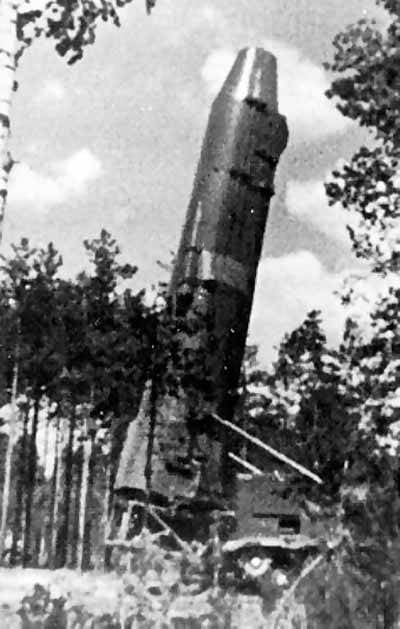
The container with the rocket rises from the self-propelled launcher in the pre-launch position. Photos from http://zonwar.ru
According to the preliminary plan, tests of the complex with the participation of the transport-launcher and the RT-15 rocket were supposed to begin in the autumn of the 1963 year, but did not begin. The problem turned out to be in the “head” rocket RT-2, the tests of which did not work out, and accordingly, because of them, the tests of the “reduced” version of the rocket, PT-15, were also suspended. In the meantime, the designers were refining solid engines of the "two", the military, who appreciated the convenience of a single transport and launch container used for the UR-100 missile tested, decided to adapt it to the "tag". New tactical and technical requirements of the customer, providing for the launch of the rocket directly from the transport and launch container installed on the mobile chassis, appeared in August 1965. And the designers had to significantly rework the project self-propelled launch platform.
Army experiences
Since it was impossible to simply take and adapt the first two prototypes for the new TPK, they were left alone and even drove around Red Square during the November 1965 and 1966 parades. Meanwhile, SKTB specialists in Khotkovo, located near Moscow (the current Central Scientific Research Institute of Special Engineering), specializing in polymer and composite materials for the rocket and space industry, created a new transport and launch container in which the RT-15 rocket was placed directly at the plant. The chassis has remained the same, but it has been finalized, since the lifting and installation mechanisms of the WPK and the preparation for launch also had to be redone.

Schematic diagram of placement of the PT-15 rocket in a transport-launch container of a new type. Photos from the site http://rocketpolk44.narod.ru
A new version of the transport-launcher began to be assembled at the same Kirov factory as the first prototypes. By this time, the autumn of 1966, it was possible to resolve the main problems associated with the reliability and stability of the engines of all three stages of the P-2 rocket, and therefore its reduced version of the PT-15. And in November, 1966, at the Kapustin Yar test site, the tag tests began. It is noteworthy that two sites of the landfill — 105 and 84 — were set aside to conduct them. On the first of them, on which the RT-2 missiles were previously tested, all tests and prelaunch checks of the rocket were carried out in the vertical position of the transport and launch container, after which it was lowered, and the transport and launch device in the stowed position was moved to another platform, from where rocket starts. At the same time, in the first stages, the personnel who participated in the launches, hid in the underground command post, which was part of the 84 platform, and placed the command equipment of the complex there.
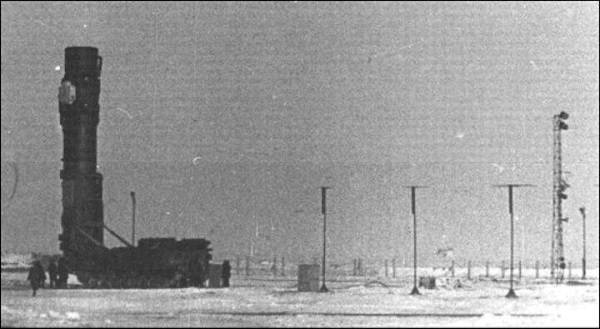
Self-propelled launcher with a PT-15 rocket at site 84 of the Kapustin Yar test site. Photos from http://www.globalsecurity.org
Until the end of 1966, three launches of the RT-15 were carried out, and over the next year, three more launches, practicing the technology of preparing and implementing missile launches. The main launches at the Kapustin Yar test site were conducted by the mobile combat missile system 15P645 in the 1968 year - eight times. And then began the launches already in the three launchers 15U59 installations 15N809 command and control machines, training 15V51 position, communications node as part of 3-x machines, two diesel power plants and transport and loading and mating machines 15T79, 15T81, 15T84, 15T21P. Moreover, these were both single launches and launches with the development of the duty of the complex in full force: during the tests, two two-missile volleys were made.
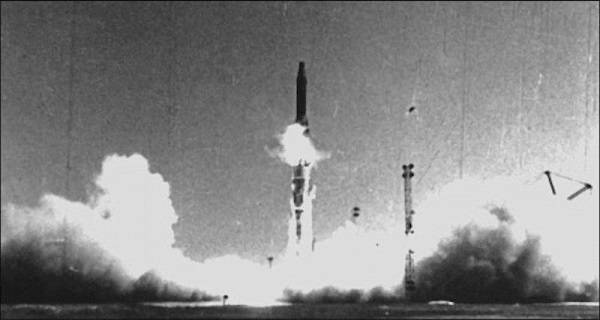
The launch of the RT-15 rocket from a self-propelled launcher at the site No. XXUMX of the Kapustin Yar test site. Photos from http://www.globalsecurity.org
A little earlier than the flight design tests of the RT-15 rocket began, which was launched at the Leningrad Arsenal plant, in the design bureau of which it was developed, military tests of the missile complex began in their original form - that is, without transport-launch containers. They passed by order of the commander-in-chief of the Strategic Missile Forces on the basis of two divisions - the 638 th missile regiment of the 31 th missile division stationed near the town of Slonim in the Grodno region of Belarus, and the 323 th missile regiment of the 24 th missile division housed near the city of Gusev Kaliningrad Neither combat nor training launches during these tests were carried out, and according to some data, the personnel employed at these events dealt not even with training missiles, but with mass-dimensional mock-ups. Nevertheless, it was possible to work out the questions of the combat use of self-propelled launchers, determine the temporary standards for occupying and abandoning positions, the scope and procedure for servicing launchers, and develop an indicative rocket complex staff.
And in December of the same 1966 of the year, when flight tests of the RT-15 rocket had already started at the Kapustin Yar range, taking into account the developments of the autumn military tests in the 50 rocket army, two missile divisions were formed, which were to be the first to take on military tests full-fledged complexes 15P645. One division was part of the 94 th missile regiment of the 23 th missile division, stationed near the city of Haapsalu in Estonia, and the second was the 50 th separate missile division at the 638 th missile regiment of the 31 th missile division, where the first stage of the military tests was conducted complex.
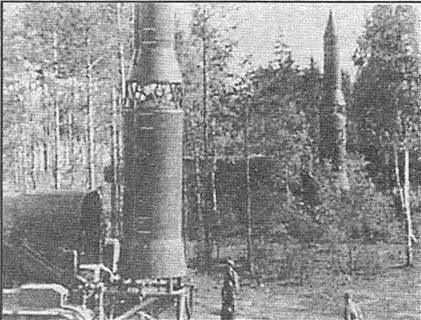
Mockups of missiles RT-15 on the launchers of the old model during the first stage of military tests. Photos from http://www.k2x2.info
"Disgraceful", who became the "scapegoat"
It was 50-th separate missile division that eventually became the first and only division of the Strategic Missile Forces, which was armed with the first domestic mobile combat missile system with a solid-fuel medium-range ballistic missile. 6 January 1969 of the year, after the end of the State tests, by decree of the USSR Council of Ministers, the 15P696 complex with the RT-15 rocket was recommended for adoption by the Strategic Missile Forces. True, only for trial operation, which would allow to study and test the combat use of medium-range ballistic missiles on self-propelled launchers, and only in the number of one regiment - that is, six launchers and a command post. True, it was rather big, because it consisted of eight vehicles, including seven - on the MAZ-543 “rocket-carrying” chassis: 15H809 combat control vehicle, 15В51 position preparation machine, two 15Н694 diesel power stations and three vehicles as part of a mobile node communications "Relief" (the eighth was a personnel van).
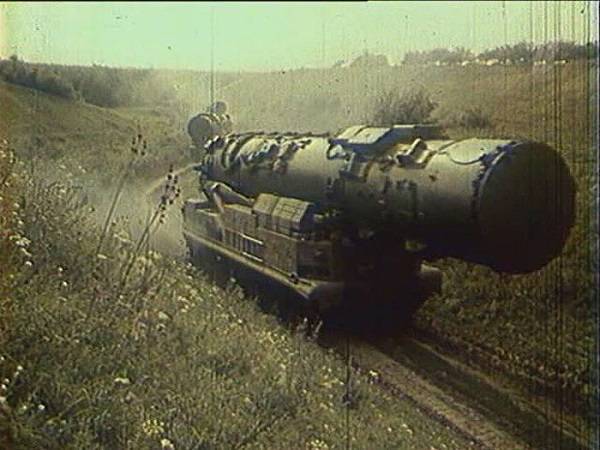
Self-propelled launcher for the RT-15 rocket with a transport and launch container on a military march. Photos from http://militaryrussia.ru
The newly created division was based on the Lesnaya missile base near Baranavichy. In March, all six installations of the complex and the mobile command center, as well as all other machines, entered the 50 separate rocket division, and its personnel began to work on combat missions. Alas, in open sources no exact information was found about what they were and how they were carried out. One can only assume that the division was practicing the actions that it was supposed to perform in real combat conditions. In other words, the soldiers and officers of the division carried out routine maintenance and maintenance of self-propelled launchers in the place of permanent deployment, left it in alarm and moved to combat deployment sites, occupied positions, deployed the complex and practiced conditional launch.
This was not an easy task: according to its idea, the 15P696 mobile combat missile system was supposed to provide autonomous combat duty, automated pre-launch preparation and a volley launch of six missiles at any time of the year or day, without special preparation of the combat position. At the same time, the complex had to quickly occupy this position and just as quickly collapse to move to a new one: the ideology of its application was based on the principle of short-term combat duty in any arbitrarily chosen place, with full autonomy and automation of the processes of power supply, aiming and starting from constant or full combat readiness. At the same time, the combat order of the complex looked very original and, as they say, beautiful. It was a hexagon, in the center of which the 15H809 command and control vehicle was installed with high geodetic precision. The “heart” of the machine was a hexagonal prism, to the edges of which, using optical methods, sighting devices for self-propelled launchers 15У59 were attached.
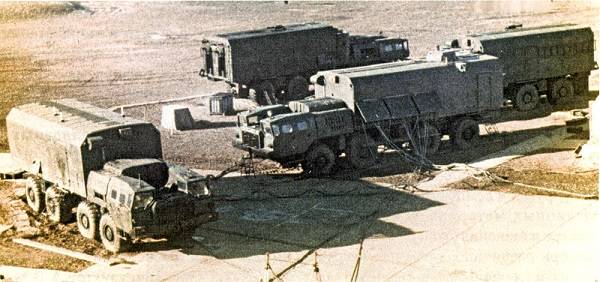
Machines from the command post of mobile combat missile system 15P696. Photo from http://www.russianarms.ru
But no matter how active was the service of the personnel of the 50-th separate missile division, neither real training launches, nor even combat ones, he carried out. After the 1970 of the year, when the last two test launches were performed at the Kapustin Yar test site, not a single RT-15 rocket took off into the air. Yes, and this was not possible: the same decree of the Council of Ministers, which adopted the complex in trial operation, the production of "Fifteen" at the Leningrad plant "Arsenal" had M.V. Frunze was discontinued, and only those missiles that had been produced before were left at the disposal of the military. And in the 1971 year, the mobile combat missile system for which they were produced was also removed from trial operation. As for the only unit commanded by Lieutenant Colonel Sergey Drozdov, the 50-th separate missile division existed for another two years after the complex was removed from trial operation and 1 was disbanded on July 1973.
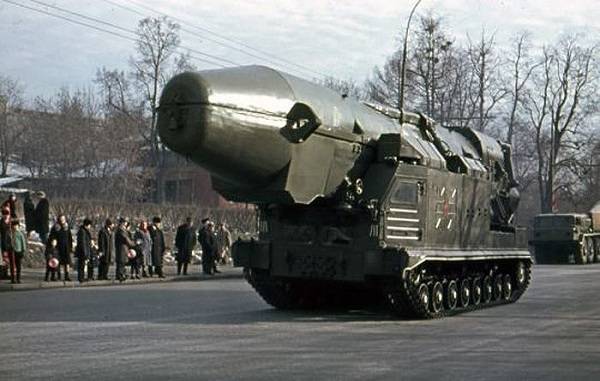
The first prototype of the SPU for the RT-15 rocket is moving to the November parade in Moscow. Photo from http://www.arms-expo.ru
It is noteworthy that until the middle of 1970-x in the NATO directories, the same complex 15P696 had two different names. The reason for this is the difference in containers for the PT-15 missiles. The first version of the self-propelled launcher, which first traveled around Red Square in 1965, was called Scamp, that is, “outrageous” (this translation option is preferable considering the nature of the installation). Seeing the same container on a slightly modified chassis a year later, foreign intelligence officers took it for a modification of the same complex. But then, when Western intelligence agencies received images of the same chassis with a new transport and launch container, and then data on test launches from these installations, they assigned them the SS-X-1968 index in 14 year (“X” indicates the experimental character armament) and the name of Scapegoat, that is, the “scapegoat”. And only seven or eight years later, having figured out what was the matter, NATO experts assigned both names to the same complex, which in their reference books was listed as fighting until 1984 of the year.
Information